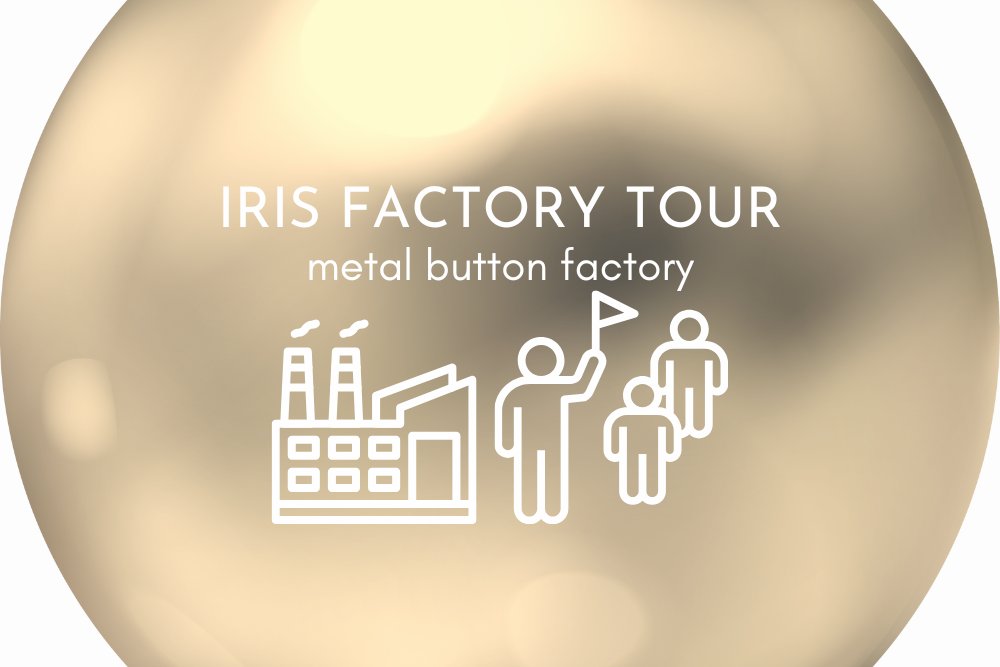Yajima Factory, Metal Buttons
Last year, some of our colleagues were invited to tour 3 of Iris’s factories. In this article, we’ll go over their Yajima metal button factory.

The Yajima Factory is the factory headquarters.
Here, we have a metal production department where they manufacture and plate metal buttons.
The company sells many custom-made items with exclusive designs for school uniform buttons and other items.
Not all processes are carried out in-house, and some are outsourced.
What are metal buttons?
The main raw materials for metal buttons today are brass and zinc, and there are a wide variety of plating options.
You may have seen them on school uniforms and blazers.
Buttons commonly seen on school uniforms are made of brass and are often embossed or cut.
About metal material types
Brass
Brass is an alloy of copper and zinc.
Its ductility allows it to be processed by both pressing and cutting.
Die-casting (zinc die-casting, rubber casting)
Die casting using zinc allows for even finer relief than brass,
making it possible to create delicate designs and voluminous objects that cannot be achieved by press processing.
Furthermore, for complex motifs, there are techniques such as rubber casting, in which molten metal is poured into a rubber mold.
Aluminum
Used for the shanks of covered buttons, etc.
Brass button manufacturing process
● One piece

A thick sheet of brass is pressed into the shape of a button.
The legs are attached by soldering.
Rough Process
Plate material → ★ Pressing → ★ Punching → ★ Soldering (legs) → Honing → Polishing, plating → Painting → Inspection
** ★ is part of the process we’ll go over below
Press processing


The front and back of a thick brass plate are pressed at the same time. We weren’t allowed to take photos of the machine, but it was a large press machine.
Soldering

The parts are bonded in a large machine using a paste-like metal called solder.
They can be baked up to 800 degrees.
Items are placed on a conveyer belt like an assembly line.
Not only the button shanks, but also the parts of the rank insignia are soldered in place.
When we visited the button factory, the rank insignia were being soldered.
● Hollow (covered) metal button

The inside is hollow, and the button is made by joining the front and back parts together and crimping them together.
Rough process
Brass material → ★ Pressing → ★ Punching → Honing → Cutting → ★ Crimping → Polishing, plating → Painting → Inspection
Press processing

A thin brass tape is pressed with a plate.
Some buttons are outsourced for plating in this state, and the surface of the plating is scraped off with a machine to give them a special texture. (Since these were custom-made buttons, there are no images.)





Crimping


There were automatic machines that uses a camera to set and rivet, and machines that required manual setting.
The difference between them seems to depend on whether the item can or cannot be put into the automatic machine and on the delivery date.
The holes on the back are for draining water since the parts are plated after being crimped.
Cast button
●Rubber cast

Rough process
Material → Melt in furnace → Form with rubber → Deburring → Polishing → Plating → Painting → Inspection
We weren’t able to see the manufacturing process at the button factory, but there were samples of the molded rubber on display.
Automatic hole cutting machine

There was a machine that polishes the bases of cast buttons.
They are often used for a long time on uniforms, so we polish them to prevent the threads from breaking.
EPO Cutting Machine

There was a machine that carved the surface of buttons made by pouring epoxy resin into die-cast buttons with feet.
By sanding down the surface, letters and patterns emerge.
Other machines
There were also machines like the ones below at the metal button factory!
Machine for processing buckle pins and rings

This machine automatically bends and cuts the pins and loops used in buckles. It bends a long rod and cuts it.
Seeing the processing site, and it was quite interesting to see the pins and loops flying out (with great force might I add!).
Cleaning machine
There was a large cleaning machine that removes oil and other substances before plating.
A solvent is used to clean the buttons.
Summary
They showed us many samples of custom-made buttons. Among them were buttons from a certain famous theme park, and we were surprised to see that they were made by Iris. We were surprised to see that Iris makes the buttons for those places too, and it made us appreciate them more.
I had noticed that there was a hole on the back of the flap button, but I had never thought about what the hole meant, so this was a learning experience for me.
We’ll post some more factory tours posts later so keep an eye out for them!
ApparelX is a BtoB ecommerce platform for brands, tailors and the like to order from small MOQs from a variety of manufacturers in one order. And we ship worldwide!
Check out our FAQ page, Youtube, and LinkedIn if you have basic questions or looking to stay connected.
If you are looking to bulk order, custom order, or have any other questions, contact us through our contact form and a member on the Global Strategy Team will get back to you within the next business day. (Please understand that we are based in Japan and our office hours are 9am-6pm so we are only able to answer during that time).


